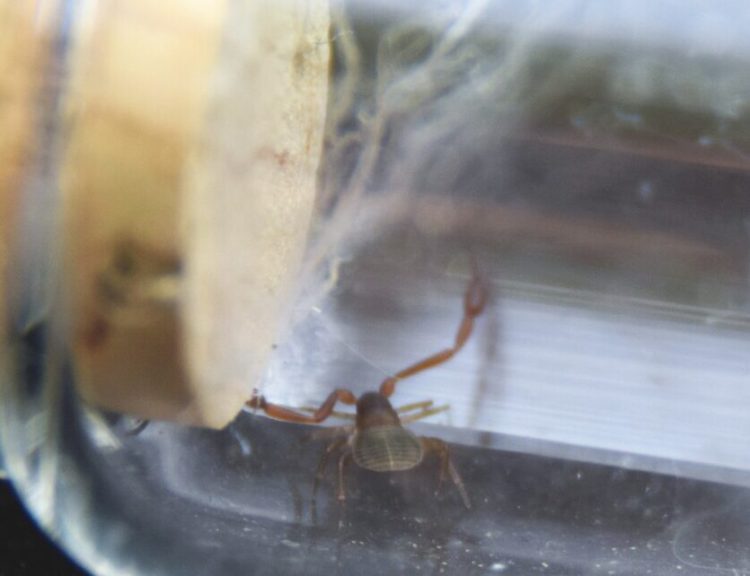“There’s a spider in here,” Bonnie said, “crawling around by the sink. It’s really small.”
Her voice was three-fifths enthusiastic and two-fifths disgusted. One of the many sacrifices she makes to my many weird behaviors is to let me know when she spots a spider. It makes her feel better to think she’s helping out, even about tiny monsters. I went into the bathroom to look.
“It’s not a spider.”
“Then it’s a tick. Kill it.”
“It’s not a tick, either,” I said. “It’s a pseudoscorpion.”
“Is that why it has those big claws?”
Big. The creature itself was tiny, no more than 3 millimeters in body length. But it was menacingly waving these huge (relatively speaking) pincers on long crablike arms. These arms are technically known as pedipalps, a version of the same organs you see on spiders, except pseudoscorpions are not spiders. They’re not ticks or mites either, and they’re not even scorpions, which are much larger and have a stinging tail that the pseudoscorpion does not have.
The beast on the bathroom sink is commonly known as a house pseudoscorpion, aka Chelifer cancroides, of the order Pseudoscorpiones, and are sometimes known as book scorpions or false scorpions. They’re arachnids, like spiders, ticks and mites, all significantly different each from the others, but similar in having eight legs. They have chelicerae, or jaws, similar to those of spiders and mites. The pseudoscorpion’s pedipalps have glands that produce a prey-subduing venom believed to contain a neurotoxin. They attach themselves to the leg or body of their prey, inject the poison, and then suck out the liquid.
Pseudoscorpions are more common than you probably think, though they’re not well-studied. They fit largely unseen into a lot of habitats in North America, Europe and elsewhere. They’re found in houses, especially around sinks and counters, and in bird’s nests, barns and forest floor litter. They eat other tiny beings such as mites, flies, ants, moth larvae, booklice, even caterpillars, as well as springtails, tiny bugs that are not insects but live in gardens, for example. Pseudoscorpions also are thought to be useful predators on the Varroa destructor mite, which can decimate honeybee hives. They’re not dangerous to humans at all, and as far as anyone knows, they do no damage in your house.
I herded Bonnie’s pseudoscorpion into a vial, where it stayed for a couple of days before I could try to get a photo of it. When I looked, I was surprised to see it had spun an elegantly sweeping silk web inside the vial. It turns out pseudoscorpions have silk glands near the tips of their chelicerae.
The female (upon completion of what are apparently quite complex mating routines) spins a pouch where she deposits her eggs. After about three weeks, the eggs hatch and the pseudoscorpionlings (not a technical term) stay with the mother through their first molt (of three), in some species riding around on the mother’s back. They overwinter in silk cocoons. I think the pseudoscorpion in my vial might have been a female fashioning a retreat.
After I got a few photos, I told Bonnie I had let her pseudoscorpion go, as I always do with my captives.
“I hope it’s outside,” she said.
“Yes, outside,” I said. “Though it would actually be our friend in here against mites and fruit flies.”
“You’re weird,” she said.
“It’s a weird world,” I said. “I’m just trying to fit in.”
Dana Wilde lives in Troy. You can contact him at naturalist1@dwildepress.net. His recent book is “Summer to Fall: Notes and Numina from the Maine Woods” available from North Country Press. Backyard Naturalist appears the second and fourth Thursdays each month.
Send questions/comments to the editors.



Comments are no longer available on this story